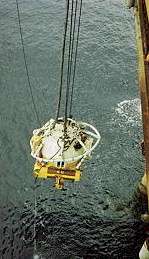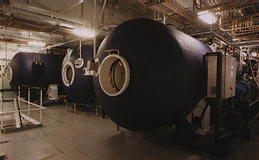Hannes Keller
In 1962 a Swiss guy named Hannes
Keller reached a depth of 300 meters on a breathing mixture of helium and
oxygen. He used a different technique: he went down in a small diving bell in
which the pressure was a little higher than that of the outside surrounding
water. In this way he could open a hatch once he arrived on the bottom and swim
to his job. The gas was supplied to him from the bell by an umbilical. An
umbilical can be defined as a multifunctional life-line. It runs down from the
surface ship to the bell and from the bell to the diver. It has been further
professionalised in later years and is still in use today. It may supply things
like breathing gas, electricity (for the lights and tools), hot water,
communication wire and any other source that is needed under water.
In fact Keller created the pillar
for future military, scientific and commercial diving.
George Bond
Dr. Bond was the director of the US Navy Submarine
Medical Center in 1957. He deserves the credits for developing saturation
theories. He found that the tissues of animals and humans would eventually
become completely saturated with the inert gas after a particular time of
exposure to it. They would then be filled up and not absorb anymore.
As long as the diver stayed at the depth where he
saturated, his decompression period would be unaffected, even if he stayed days
or weeks.
What is saturation diving and
how does it work ?
Depending on the depth and the
time the diver stays there, the tissues in the divers body collect gasses from
the surrounding environment relatively quick until a point of saturation
is reached.
After a deep dive a diver has to
decompress. His decompression time is often much larger than his actual diving
time. For example: a dive to 180 meters for 1 hour will take the diver 38 hours
to decompress ! If it takes several deep dives to finish a job, the total time
will be very long (and expensive)!
After reaching the point of
saturation the decompression time makes no difference anymore. Did the
diver stay under the pressure for this one dive of 1.5 hours or for one week ?
He has to decompress for a certain equal time (depending on the depth).
So, ways had to be found to bring and keep divers under the pressure of the dive
depth, let them finish the complete job and decompress them only once.
Underwater Habitats
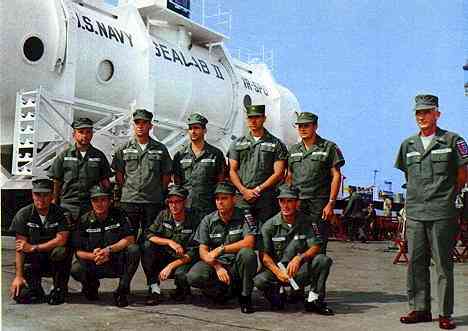 |
Experiments were carried out by Jaques Cousteau
with his Conshelf underwater habitat and by the Experimental Diving
Unit, lead by Dr. Bond. In the early 1960-ies they developed
underwater habitats Sealab I and II. In Sealab I four divers lived in a
depth of 65 meters for 10 days. In Sealab II teams of 10 divers stayed
underwater for periods of 15 days in a depth of 70 meters. Heliox was used as
the breathing gas.
These experiments were very valuable but the underwater
habitats turned out to be very expensive and complex to maintain. Life support
umbilicals were extremely vulnerable due to currents, storms etcetera. In the
1980-ies all underwater habitats had disappeared. It was preferred to leave
saturation complexes on the surface support ship.
|
Surface Saturation Complexes
|
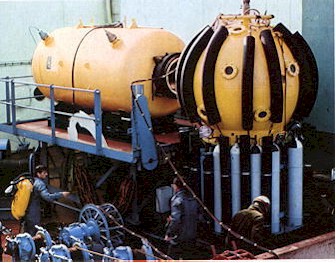
|
The first Surface Saturation System
was the SDC (Submersible Diving Chamber). A well known SDC in the 1960-ies
was the Seashore. It had a cabin that could transport two divers to a
maximum of 200 meters. Divers left the cabin through a hedge to start their
job. After work was finished the cabin was brought back on deck and
connected to the Deck Decompression Chamber (DDC). Here they waited till
they were needed again. After the whole job was finished the divers
underwent full decompression in the DDC.
|
Modern ways of saturation diving
The principal is as follows. The
divers are brought under the pressure of their next job in a surface pressure
chamber. This system is often called a Deep Diving System (DDS). A DDS is
sometimes portable but many times to bulky to transport and mounted permanently
on diving vessels. The DDS will be the home for the saturation divers for some
weeks. It contains medical facilities as well as showers, toilets, beds, tables,
heating, a built in breathing system (BIBS) etcetera. Food, drinks and other things the divers need are supplied through a
small attached pressure vault.
|
As soon as the divers are under
the pressure of that specific dive sequence and all systems are checked they can
start their job by entering the Personnel Transport Cabin (PTC). This is a small
diving bell attached to the DDS and under the same pressure. heating,
communications equipment, video cameras etcetera. In the PTC the
divers enter the water and they descend to their job. Since the pressure there
is the same they can immediately exit the PTC and start their work. Like in the
first attempts of Hannes the diver is supplied with his breathing gas,
communication facilities, hot water to heat his suit and electricity for his
tools and lights by the umbilical (an umbilical also comes down from the diving
vessel to the PTC.
When his "turn" is over
he re-enters the PTC and his mate can go out to do his part of the job. There is
always one guy left behind in the PTC. He is called the "bellman" and
he monitors the systems. After the shift is over they will surface in the PTC
that will be re-locked to the DDC. Now the divers can rest, sleep, eat, shower
and relax until their next dive.
|
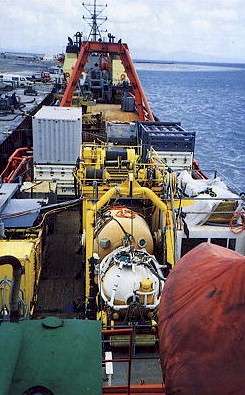
Modern Sat system on board an off shore oil
platform
|
A saturation team of 6 divers can operate
continually , with one diver always on the job, 24 hours a day for up to 30 days
or longer.




